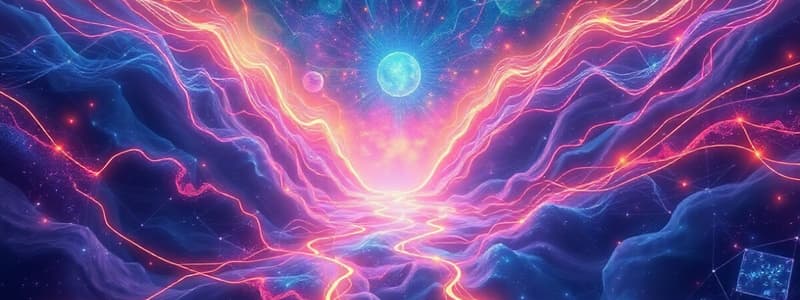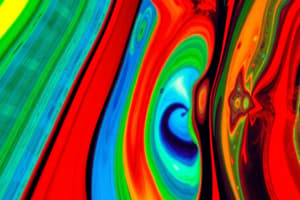Podcast
Questions and Answers
What does the place theory primarily explain about auditory perception?
What does the place theory primarily explain about auditory perception?
- All frequencies are coded by the same place on the basilar membrane.
- The firing rate of neurons in the auditory nerve matches sound frequency.
- Hair cells at specific locations on the basilar membrane respond to particular sound frequencies. (correct)
- The temporal patterns of sound waves are crucial for recognizing pitch.
Why does place theory struggle to account for very low frequencies?
Why does place theory struggle to account for very low frequencies?
- The basilar membrane does not respond to low frequencies at all.
- Very low frequencies are only detected by the outer ear.
- Low frequencies create very weak sound waves that are hard to detect.
- There are no auditory nerve fibers that respond to very low characteristic frequencies. (correct)
How does frequency matching theory operate in the auditory system?
How does frequency matching theory operate in the auditory system?
- It does not involve any type of neuronal firing pattern.
- It relies solely on the location of peak displacement on the basilar membrane.
- It codes all frequencies in the same manner through a single type of neuron.
- It matches the firing rate of auditory nerve fibers to the frequency of sound waves. (correct)
Which statement accurately describes the coding of sound frequencies in the auditory system?
Which statement accurately describes the coding of sound frequencies in the auditory system?
At what speed would neurons fire if they respond to a sound wave of 25 cycles per second?
At what speed would neurons fire if they respond to a sound wave of 25 cycles per second?
What is the primary focus of psychopharmacology?
What is the primary focus of psychopharmacology?
What characteristic distinguishes agonists from antagonists?
What characteristic distinguishes agonists from antagonists?
Which drug type acts to inhibit the functioning of the central nervous system?
Which drug type acts to inhibit the functioning of the central nervous system?
What phenomenon describes the inability to recall events that occurred during hypnosis?
What phenomenon describes the inability to recall events that occurred during hypnosis?
What percentage of adults are reported to be difficult or impossible to hypnotize?
What percentage of adults are reported to be difficult or impossible to hypnotize?
Which type of drug is commonly associated with producing sleep-inducing and pain-relieving effects?
Which type of drug is commonly associated with producing sleep-inducing and pain-relieving effects?
What defines a CNS stimulant drug?
What defines a CNS stimulant drug?
What does the blood-brain barrier primarily do?
What does the blood-brain barrier primarily do?
What is the primary function of photopigments in photoreceptors?
What is the primary function of photopigments in photoreceptors?
What distinguishes rods from cones in the retina?
What distinguishes rods from cones in the retina?
How does visual acuity vary across the retina?
How does visual acuity vary across the retina?
What aspect of color does hue specifically describe?
What aspect of color does hue specifically describe?
Which theory of color vision explains color sensitivity as groupings of red-green, blue-yellow, and black-white?
Which theory of color vision explains color sensitivity as groupings of red-green, blue-yellow, and black-white?
Which type of cone is most sensitive to light in the blue range?
Which type of cone is most sensitive to light in the blue range?
What occurs during dark adaptation?
What occurs during dark adaptation?
Which component of the visual system carries visual information to the brain?
Which component of the visual system carries visual information to the brain?
What is the process of converting incoming energy into neural activity called?
What is the process of converting incoming energy into neural activity called?
Which statement best describes sensory adaptation?
Which statement best describes sensory adaptation?
What does Weber's Law state about the detection of stimulus change?
What does Weber's Law state about the detection of stimulus change?
What term describes stimuli that are too weak or brief to be perceived?
What term describes stimuli that are too weak or brief to be perceived?
What part of the brain receives sensory information before processing it?
What part of the brain receives sensory information before processing it?
According to psychophysics, what is the main focus of study?
According to psychophysics, what is the main focus of study?
Which of these is an example of topographical representation in sensory perception?
Which of these is an example of topographical representation in sensory perception?
What is meant by absolute threshold in sensory perception?
What is meant by absolute threshold in sensory perception?
What is the primary function of the cochlea in the inner ear?
What is the primary function of the cochlea in the inner ear?
Which type of nerve fibers are responsible for sharp, prickling pain sensations?
Which type of nerve fibers are responsible for sharp, prickling pain sensations?
What phenomenon explains why we sometimes do not feel pain?
What phenomenon explains why we sometimes do not feel pain?
What characteristic defines a perceptual illusion?
What characteristic defines a perceptual illusion?
Which Gestalt law explains why we group elements that are close together?
Which Gestalt law explains why we group elements that are close together?
What is the role of cones in the retina concerning color vision?
What is the role of cones in the retina concerning color vision?
Which process emphasizes how learned experiences influence perception?
Which process emphasizes how learned experiences influence perception?
Which part of the inner ear is primarily involved in maintaining equilibrium?
Which part of the inner ear is primarily involved in maintaining equilibrium?
What are proprioceptors responsible for detecting?
What are proprioceptors responsible for detecting?
Which approach to perception suggests that we perceive the world based on learned adaptations?
Which approach to perception suggests that we perceive the world based on learned adaptations?
What causes near-sightedness and far-sightedness?
What causes near-sightedness and far-sightedness?
What sensation do A-delta fibres primarily convey?
What sensation do A-delta fibres primarily convey?
Which of these describes the concept of 'figure-ground discrimination'?
Which of these describes the concept of 'figure-ground discrimination'?
What do vestibular sacs specifically contribute to?
What do vestibular sacs specifically contribute to?
Study Notes
Sense
- Translates information into neural activity.
- Responds to energy like light, sound, heat, and pressure.
- Neural receptors detect specific forms of energy.
- Transduction converts incoming energy into neural activity.
- Sensory adaptation decreases responsiveness to constant stimuli.
- Except for smell, sensory information goes to the thalamus, then to the cerebral cortex.
- The absolute threshold is the minimum stimulus energy detectable 50% of the time.
- Subliminal stimulation is too weak or brief to be perceived.
- Supraliminal stimulation is strong enough to be consistently perceived.
- Psychophysics studies the relationship between stimuli and psychological experiences.
- Topographical representations map similar features to nearby neurons.
- Sensitivity is the ability to detect a stimulus amidst competing ones.
- Weber's Law states the smallest detectable difference in stimuli is a constant fraction of the original stimulus intensity.
Vision
- Photopigments in photoreceptors respond to light.
- Dark adaptation increases light sensitivity over time.
- Rods allow dim-light vision but not color distinction.
- Cones enable color vision and are concentrated in the fovea.
- Visual acuity is highest in the fovea due to cone concentration.
- Light passes through retinal layers before reaching rods and cones.
- Signals from rods and cones travel to bipolar and ganglion cells.
- Ganglion cell axons form the optic nerve, carrying visual information to the brain.
- Feature detectors in the cerebral cortex respond to specific object features.
- Psychological dimensions of color include hue, saturation, and brightness.
- The trichromatic theory proposes three types of cones sensitive to different wavelengths (blue, green, red-yellow).
- The opponent-process theory suggests color-sensitive elements are grouped into red-green, blue-yellow, and black-white pairs.
Hearing
- Sound energy is converted to neural activity in the cochlea.
- Nerve deafness occurs due to damage to hair cells or the acoustic nerve.
- Pitch is determined by sound wave frequency.
- Place theory suggests specific hair cells on the basilar membrane respond to specific sound frequencies.
- Frequency matching theory (volley theory) proposes that auditory nerve firing rate matches sound wave frequency.
- Low frequencies are coded by frequency matching, moderate frequencies are coded by both, and high frequencies are coded by location on the basilar membrane.
Taste and Smell
- Without taste, swallowing would be difficult without choking.
Touch
- Cutaneous senses include touch, temperature, pain, and kinesthetic perception.
- A-delta fibers carry sharp, prickling sensations.
- C-fibers convey dull, aching, and burning sensations.
- The gate control theory suggests a spinal cord ' gate ' regulates pain impulses.
- Analgesia is pain absence despite a painful stimulus.
Proprioception
- Proprioceptors provide information about body parts and their movements.
- The vestibular sense provides information about head and body position and movement.
- Vestibular sacs, containing otoliths, detect head orientation.
- Semicircular canals detect head movements.
- Kinaesthetic perception tells body part location relative to each other.
Perception
- Perception interprets sensory information using knowledge and experience for meaning.
- Computational model focuses on how the nervous system processes sensory information into perception.
- Constructivist approach suggests perception builds images from sensory fragments.
- Ecological approach argues for adaptive perceptions within natural environments.
- Perceptual organisation determines which stimuli belong to an object.
- Figure-ground discrimination separates figures from the background.
- Gestalt laws of grouping include proximity, similarity, continuity, closure, texture, simplicity, and common fate.
Hypnosis
- Hypnosis is an altered state of consciousness according to state theories.
- Non-state theories suggest role-playing rather than an altered state.
- Dissociation theory proposes a reorganization or breakdown of normal thought and action control.
- Hypnosis has uses in memory aid, pain management, research, and insights into cognitive processes.
Psychoactive Drugs
- Psychoactive drugs affect the brain, altering psychological states.
- Psychopharmacology studies psychoactive drugs and their effects.
- The blood-brain barrier regulates substances entering the brain.
- Agonists mimic neurotransmitter effects.
- Antagonists block neurotransmitter binding.
- CNS depressant drugs inhibit CNS function (barbiturates, alcohol).
- CNS stimulants increase behavioral and mental activity.
- Opiates induce sleep and relieve pain (opium, morphine, heroin).
- Hallucinogenic drugs alter consciousness and perception (LSD, psilocybin).
Studying That Suits You
Use AI to generate personalized quizzes and flashcards to suit your learning preferences.
Related Documents
Description
This quiz covers key concepts related to sensation and vision, including the mechanisms of transduction, sensory adaptation, and the role of the thalamus and cerebral cortex. It also explores psychophysics, absolute threshold, and Weber's Law. Test your understanding of how we perceive and interpret sensory information.




